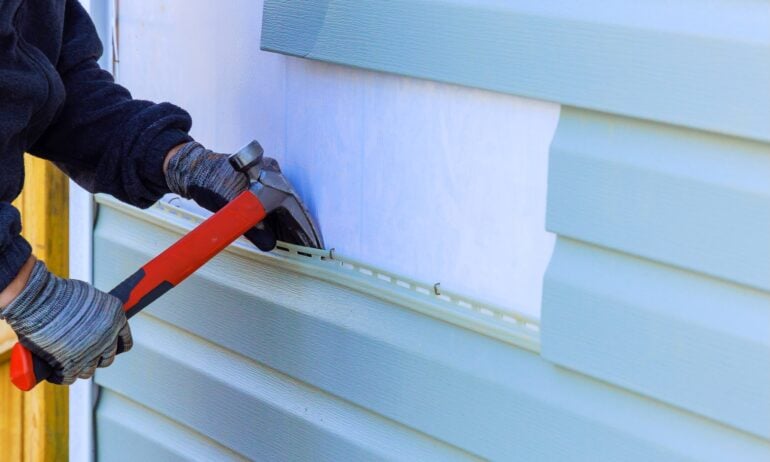What Is the Cost to Replace Vinyl Siding in 2025?
Vinyl siding quality and home size are two of the biggest factors that determine vinyl siding replacement cost.

Some or all of the mortgage lenders featured on our site are advertising partners of NerdWallet, but this does not influence our evaluations, lender star ratings or the order in which lenders are listed on the page. Our opinions are our own. Here is a list of our partners.
The cost to replace vinyl siding is about $3 to $12 per square foot installed. For most homeowners, that amounts to a cost range of $6,369 to $18,274, with an average of $12,221, according to home services website Angi.
The final cost depends on factors such as type of vinyl siding, home size, complexity of the job and where the home is located.
Vinyl siding grade affects cost
Vinyl siding comes in different grades and thicknesses, which differentiates lower-quality and more affordable options from higher-quality, more expensive ones. In general, thicker vinyl siding is more durable and lasts longer, at an additional cost.
Vinyl siding types and costs
Siding type | Price installed (per square foot) | Estimated total (2,000-square-foot home) |
|---|---|---|
Economy/builder’s
| $3.50 to $5.50. | $7,000 to $11,000. |
Standard residential
| $4.50 to $7. | $9,000 to $14,000. |
Thick/Premium
| $6 to $10. | $12,000 to $20,000. |
Insulated
| $7 to $13. | $14,000 to $26,000. |
Vinyl siding panels also come in different lengths. Standard panels are 12.5 feet, which can cause more seams and may be less visually appealing. High-quality siding can be longer, which minimizes the number of seams, but can require more time to ensure it’s straight and installed correctly.
How your house affects vinyl siding cost
Your home is the biggest contributor to vinyl siding project cost due to these factors.
House size. Understandably, replacing siding on larger homes requires more materials and labor, increasing the cost.
House design. Complex architecture — such as multiple gables or intricate rooflines — typically cost more because of the need for additional cutting and fitting. The number of windows is also a factor.
Home location. Vinyl siding availability and costs vary by region. For example, it stands up well in the face of weather changes in the Northeast and Midwest, so it’s easier to find and less expensive. It has a tendency to warp and crack, though, from high temperatures in the South, making it less available and more expensive.
Labor costs to replace vinyl siding
Labor costs to replace vinyl siding vary by location, but expect it to account for up to half of your total project cost. When you receive a per square foot price from a contractor, determine whether that includes both the cost of materials and labor.
A general range for the labor costs alone is $2 to $5 per square foot, but it could be more if you have an especially complex job. For example, removal and disposal of the existing siding is part of your labor cost. If the installer encounters difficulty when removing the old siding, it can add time and drive up labor costs.
» MORE: Can you paint vinyl siding?
Additional costs when replacing vinyl siding
Here are other factors that can drive up the cost of vinyl siding replacement.
Permits and inspections. Some areas require building permits or siding installation inspections. Costs vary by location, but you will want to be aware that these can add to your expense.
Trim pieces and accessories. When you replace your vinyl siding, you may also want to include soffit or gutter replacement costs to ensure everything is coordinated.
Repairs. When old siding is removed, it can reveal problems such as water damage or rotting wood that can quickly add thousands of dollars to your project.
Tips for saving on siding replacement
Get quotes from at least three contractors.
Choose off-season installation (winter or early spring) if possible.
Opt for standard colors and simpler styles.
Ask about possible tax incentives and rebates for insulated vinyl siding.
Ways to pay for vinyl siding replacement
Your contractor may offer some financing options (either through a partner or a payment plan), but there are other — and maybe better — financing options available.
Home equity loan or HELOC
Home equity loans or home equity lines of credit (HELOC) may have lower interest rates than financing through a contractor’s lender, as well as possible tax benefits. Both options use your home as collateral.
Home equity loan. This may be a good option if you just want to pay for the foundation repair and won’t need ongoing access to money for additional repairs. With a home equity loan, you receive a lump-sum payment and then pay it back at a fixed interest rate over an agreed period of time, typically five to 30 years.
Home equity line of credit. HELOCs work more like a credit card, so you have ongoing access to money as you need it. You usually have 10 years to draw from the line of credit and pay interest only on the HELOC amount you use. Most lenders have an option for interest-only payments during that time, after which you’re required to pay both the principal and interest. HELOC interest rates typically are variable, meaning your monthly payment could rise or fall over time.
Personal loan
Many banks, credit unions and online lenders offer personal loans, with amounts typically from $1,000 to $100,000 and with fixed annual percentage rates. You receive a lump sum and repay it in equal monthly installments over a set period, typically two to seven years. Unlike with home equity financing, there is no collateral. This means your home isn’t at risk if you get behind on payments, but you’ll still have to pay late fees and late payments can negatively impact your credit. Here are NerdWallet’s picks for the best home improvement loans.
Credit Card
Credit cards may be a good option for lower-cost siding repairs, but not a full vinyl siding replacement project. That’s because credit cards typically charge higher interest rates than home equity loans, HELOCs and personal loans. When used responsibly, credit cards can come with great benefits, such as 0% introductory APR periods that allow you to avoid interest for a set number of months; rewards so you earn cash back, travel rewards or points; and sign-up bonuses that give you extra cash back or rewards. If you go this route, you’ll want to make sure you choose one of the best credit cards for home improvements.
Why invest in vinyl-siding replacement?
According to Angi, vinyl siding offers a return on investment of around 80%, which is one of the highest ROIs for home improvement projects. Upgraded siding can improve your home’s curb appeal, resale value and energy efficiency.




